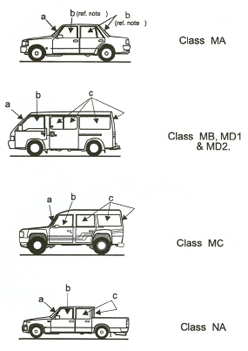Vehicle Modification Rules & Regulations
Uncertified vehicle modifications can prevent a vehicle from obtaining a WOF. Certification depends on when the modification was performed. The Vehicle Standards Regulations (VSRs) (1990) and subsequent Land Transport Rules define the dates when the various safety related standards are required to be incorporated for vehicles during manufacture and modification.
If a vehicle of an applicable class is modified after any one of these dates and the modification affects the safety related standard, the modification must be certified by the Low Volume Vehicle Technical Association (LVVTA).
If a vehicle has a modification which affects a safety standard and is currently uncertified, the owner must prove the modification was performed before the date the safety related standard was required in the VSRs or applicable Land Transport Rule. If the owner cannot show the modification was carried out before the date, the modification must be certified.
Engines, on their own, are not a subject to a safety related standard. However, if a re-power exceeds certain criteria, it can affect other related safety standards such as brakes. Brakes have to be certified after 1 January 1992. Therefore, any engine re-powers performed after 1 January 1992 that exceed the criteria must be certified.
Similarly, fitting a nudge bar under the External Projections provisions won't normally require Low Volume Vehicle (LVV) certification. However, if the nudge bar is welded to the chassis, it will affect the structural requirements and LVV certification will be required.
What you can modify
The requirements detailed here apply only to light vehicles subject to WOF (i.e., Group L vehicles, Classes MA, MB, MC, MD1, MD2, NA, TA, TB).
Significant modifications
The following illustrate significant modifications that require LVV Certification:
- An engine that is not of the same type and specification as fitted when the vehicle was manufactured
- An engine modification that significantly increases the engine's horsepower (i.e., in excess of 20%)
- A road wheel that:
- cannot be identified as being made by a recognised manufacturer, or
- is not suitable for the vehicle, or
- is not fitted in accordance with the manufacturer's instructions, or
- has been modified by heating, drilling, grinding, welding, etc
- A suspension or steering system:
- with a component that has been bent, cut, plated or heated, or
- with a repositioned steering column
Note:
Steering conversions performed by authorised agencies:
- Prior to 1 January 1994 do not require an ID plate
- After 1 January 1994 are required to have an ID plate fixed to the bulkhead with the agency name, reference number, VIN and conversion date
Steering conversions performed after 1 March 1999 must have a LVV plate fixed to the vehicle's bulkhead.
- A brake system that has been modified in any way that is not approved by the vehicle manufacturer or LVV certifier
- A body or chassis modification that may affect the strength or rigidity of the vehicle's load bearing structure, e.g.
- saloon car to convertible or utility, or
- change in chassis length, or
- addition or removal of cross members, or
- alteration of load bearing panels, mountings or brackets especially close to seat belt anchorages
We highly recommend that a Low Volume Certifier is contacted before the project begins. Contact the AA Motoring Advice Helpline for more information.
Modifications not requiring LVV Certification
Use the following list as a guide to identify modifications that individually are considered to not adversely affect the safety performance of a vehicle, provided they meet the WOF safety criteria:
- Branded wheels and tyres of a different size, provided:
- they do not project beyond the line of the original mudguard, and
- they lie within 25mm of the manufacturer's track width, and
- the tyre/wheel rolling radius is unchanged
- Changed road springs and shock absorbers that are direct substitutes for the originals, being mounted in the same way
- Suspension bushes that are direct substitutes for the originals
- Any modifications to the original engine model and type for the purpose of increasing its power by no more than 20%
- After-market steering wheels (not where airbags were originally fitted) providing they do not increase the risk of injury to the vehicle occupants
- Additional or changed instruments and accessories that are either directly ahead of the steering wheel or do not intrude into an area where they could add or cause injury to a vehicle occupant in a collision
- Cosmetic changes to the bodywork that are secure and do not reduce driver field of view or increase the risk of injury to pedestrians
- Glazing - refer to the diagram for examples of aftermarket window tinting by the application of overlays permitted on a variety of common light vehicles.
Diagram key
Visible Light Transmittance (VLT)
- Glazing marked a is required to have an overall VLT of no less than 70%. Overlays are not permitted
- Glazing marked b is permitted to have overlays applied providing the overall VLT is not reduced below 35%
- Glazing marked c is permitted to have overlays of any level of tint, including advertising overlays
Note:
- The overall VLT of the glazing is important, not the colour
- Class MA vehicles are not permitted to have glazing with an overall VLT of less than 35%. If there is glazing with an overlay behind the driver's seat, there must be an external rear view mirror fitted on each side of the vehicle
- or vehicles of classes other than MA, but including stretched limousines and body transfer vehicles, any glazing to the rear of the driver's seat may have a VLT of any level providing the vehicle has an external rear view mirror fitted

